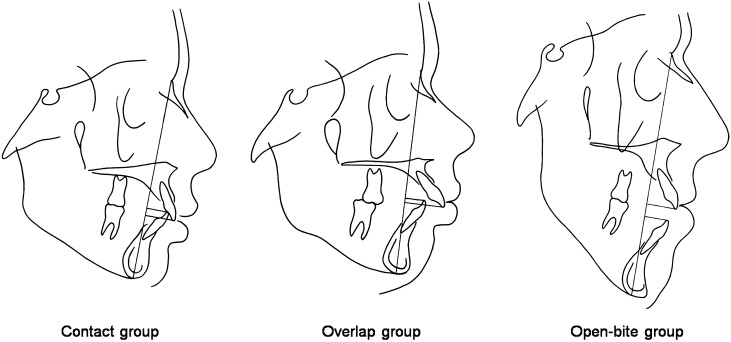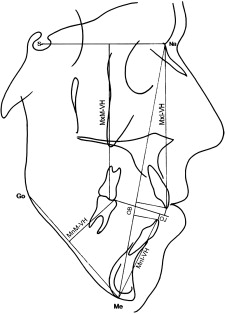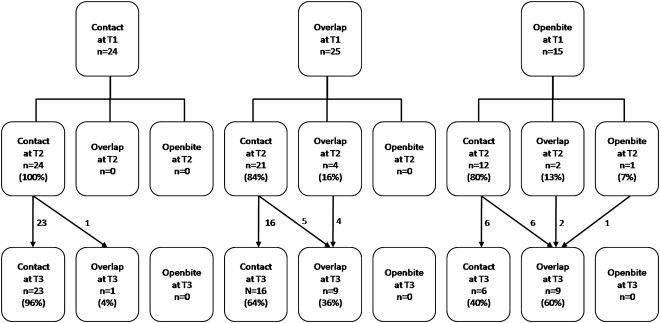Introduction
The postretention stability of open-bite treatment is a controversial topic in orthodontics.
Methods
In this study, the lateral cephalometric radiographs of 64 patients treated with orthodontics alone were evaluated to determine the amount of postretention change. The mean postretention interval was 14 years. The sample was divided into 3 groups based on the amounts of pretreatment overbite: (1) the contact group (n = 24), incisal overlap and incisal contact; (2) the overlap group (n = 25), incisal overlap and no incisal contact; and (3) the open-bite group (n = 15), no incisal overlap. The headfilms were digitized, and the values were analyzed.
Results
The 3 groups reacted differently. During the postretention period, mean overbite deepened in all groups, with the contact group deepening significantly more than the open-bite group. Overjet increased significantly more in the open-bite group than in the contact group. Pretreatment overjet correlated mildly with postretention overjet relapse in the open-bite group.
Conclusions
All 64 subjects had positive incisal overlap at the postretention recall.
Anterior open-bite therapy has long been considered a challenge to orthodontists. The prevalence of anterior open bite ranges from 1.5% to 11% among various age and ethnic groups, and it has been shown that approximately 17% of orthodontic patients have open bite. The successful treatment of open bite with well-maintained results is difficult; the combination of anteroposterior discrepancy with skeletal open bite requires the highest degree of diagnostic and clinical skill.
Today, orthodontists have many treatment options. High-pull headgear, chin cups, various types of bite blocks, functional appliances, extractions, multi-loop edgewise archwires, mini-implants, and orthognathic surgery are some examples of the treatment modalities for treating anterior open bite. However, the prognosis with those treatment modalities has been shown to be inconclusive. When considering the patient’s investment of time, discomfort, and money, the issue of stability becomes even more important.
Relapse of open bite can occur because of tongue size or posture, digit-sucking habits, respiratory problems, condylar resorption, and unfavorable growth patterns. However, no known characteristics are clear predictors of relapse.
Despite this controversy, relatively few studies have investigated the stability of open-bite treatment. Some studies were based on the results of short posttreatment periods, and some used different methods to measure vertical relationships. In addition, many previous studies neglected to separate the anteroposterior component from the vertical problem, as suggested by Sassouni, who compared subjects with open-bite characteristics with those with deep-bite. In light of these problems, we examined open-bite subjects treated with conventional orthodontics after at least 9.5 years postretention. The purposes of the study included (1) assessment of the long-term stability of anterior open bite treated orthodontically, (2) investigation of any significant cephalometric changes during the postretention period, (3) contrast and comparison of postretention cephalometric changes in patients with various categories of vertical incisal overlap, and (4) search for significant correlations between pretreatment cephalometric values and postretention changes.
Material and methods
All subjects from the postretention files at the University of Washington in Seattle were selected if they met the following criteria: (1) permanent dentition at pretreatment, (2) Angle Class I or Class II malocclusion, (3) lateral cephalometric radiographs at 3 stages (T1, pretreatment; T2, posttreatment; and T3, a minimum of 9.5 years postretention, and (4) a set of dental casts available before treatment.
The 64 selected subjects were divided into 3 groups based on the degree of pretreatment overbite or contact ( Fig 1 ). The contact group included 24 patients with incisal contact as judged by the lateral cephalometric radiograph and dental casts. The overlap group contained 25 patients with overlap of the mandibular and maxillary incisal edges as projected onto the nasion-menton line but without contact of the incisors. The open-bite group comprised patients with no pretreatment overlap of incisal edges as projected onto the nasion-menton line.

All patients were treated orthodontically with conventional edgewise appliances, and most overlap and open-bite patients were also treated with high-pull headgear.
After masking subject information with tape, the following cephalometric points were recorded directly from the films. A digitizing tablet (Scriptel, Columbus, Ohio) connected to a personal computer running Dentofacial Planner software (Dentofacial Software Inc, Toronto, Canada) was used for plotting and measurement of the following.
- 1.
Cranial base and skull: sella and nasion.
- 2.
Maxilla: central incisor incisal edge and first molar occlusal point (tip of the mesiobuccal cusp).
- 3.
Mandible: first molar occlusal point, central incisor incisal edge, menton, and gonion.
All digitizing was done by 1 investigator (J.P.Z.). Intraexaminer digitizing error was assessed by digitizing 10 headfilms at 2 times a week apart. The amount of error was expressed as the mean value for the absolute differences and their standard deviation, range of error, standard error of the mean, and the correlation coefficient between the 2 measurements.
Seven measurements were made at each time point: T1, T2, and T3 ( Fig 2 ).
- 1.
Facial height: nasion to menton.
- 2.
Maxillary incisor vertical height: nasion to the tip of the maxillary incisor.
- 3.
Mandibular incisor vertical height: menton to the tip of the mandibular incisor.
- 4.
Maxillary molar vertical height: length of the perpendicular line from the maxillary first molar occlusal point to the sella-nasion line.
- 5.
Mandibular molar vertical height: length of the perpendicular line from the mandibular first molar occlusal point to the mandibular plane.
- 6.
Overjet: distance between perpendicular lines projected onto the occlusal plane from the maxillary and mandibular incisal edges.
- 7.
Overbite: distance between perpendicular lines projected onto the nasion-menton line from the maxillary and mandibular incisal edges. Lack of incisal overlap was recorded as a negative value. Incisal overlap was recorded as a positive value or as zero when the incisal edges were at the same level.

In this study, open bite was defined as negative incisal overlap relative to the nasion-menton line ( Fig 1 ).
Statistical analysis
In part I of the statistical analysis, changes from T2 to T3 in each of the 3 groups were analyzed by using the Student t test for paired data ( P = 0.05).
Part II of the statistical procedures consisted of analysis of the correlation between the measurements at T1 with the change in those values from T2 to T3. Correlations equal to or greater than r = 0.6 were considered clinically significant. Both Pearson and Spearman correlations were used.
Part III of the statistical analysis sought to determine whether the changes from T2 to T3 were significantly different between groups established by their overbite at T1. Analysis of variance (ANOVA) was used to test the differences in the mean changes between groups. If changes for certain values differed between the 3 samples, the post-hoc Tukey studentized range test was used to determine which groups had significant differences.
Results
The method error was computed for the 7 measurements, and all values were recorded in millimeters. Mean error ranged from a high of 0.71 mm for facial height, to a low of 0.29 mm for mandibular incisor vertical height. Standard deviations ranged from 0.63 to 0.11 mm.
The sample characteristics were similar from group to group ( Table I ). The numbers of years postretention varied from 13.9 for the open-bite group to 14.5 for the overlap group, with a range of 9.5 to 33.0 years for the 64 subjects. Girls comprised 63%, 76%, and 73% of the contact, overlap, and open-bite groups, respectively. Mean age at the start of treatment was within a range of 1.2 years, at 13.1, 12.8, and 14.0 years for the contact, overlap, and open-bite groups, respectively.
| Variable | Contact group | Overlap group | Open-bite group |
|---|---|---|---|
| Sex | 9 male 15 female |
6 male 19 female |
4 male 11 female |
| Age at T1 (y) | 13.1 | 12.8 | 14.0 |
| Treatment duration (y) | 1.8 | 2.0 | 2.2 |
| Retention period (y) | 2.3 | 2.5 | 2.7 |
| Postretention period (y) | 14.0 | 14.5 | 13.9 |
| Overbite at T1 (mm) | 4.8 (2.1 to 9.5) | 1.8 (0 to 5.9) | –2.2 (–8.9 to –0.5) |
The contact group showed significant posttreatment changes for all 7 values investigated ( Table II ). These changes were also larger than the method error for each measurement. There was no significant correlation between any measurement taken at T1 and posttreatment change. When the contact group was compared with the open-bite group, there were 2 significant differences in the changes from T2 to T3 ( Table III ): the change in overjet for the open-bite group was significantly greater than that for the contact group at the α = 0.05 level, and change (deepening) in overbite was significantly larger in the contact group (α = 0.01).
| Group | Contact (n = 24) | Overlap (n = 25) | Open-bite (n = 15) | |||||||
|---|---|---|---|---|---|---|---|---|---|---|
| Variable (mm) | Mean change | SD | P | Mean change | SD | P | Mean change | SD | P | Method error |
| OJ | 0.67 | 1.05 | ∗ | 0.76 | 1.20 | ∗ | 1.70 | 1.76 | ∗ | 0.30 |
| OB | 1.61 | 1.23 | ‡ | 0.88 | 1.08 | ‡ | 0.40 | 1.06 | NS | 0.31 |
| FH | 2.86 | 3.12 | ‡ | 3.82 | 3.70 | ‡ | 3.52 | 4.23 | ∗ | 0.71 |
| MxI-VH | 2.25 | 1.90 | ‡ | 2.86 | 2.59 | ‡ | 2.69 | 2.92 | ∗ | 0.69 |
| MnI-VH | 2.10 | 1.30 | ‡ | 1.80 | 1.87 | ‡ | 1.89 | 1.84 | † | 0.29 |
| MxM-VH | 2.89 | 2.41 | ‡ | 2.58 | 3.10 | ‡ | 2.89 | 3.45 | ∗ | 0.50 |
| MnM-VH | 1.14 | 1.32 | ‡ | 0.94 | 2.27 | NS | 1.47 | 1.29 | ‡ | 0.38 |
| Open bite vs contact | Open bite vs overlap | Overlap vs contact | |||||||
|---|---|---|---|---|---|---|---|---|---|
| Variable (mean change in mm) | Open bite | Contact | Significance | Open bite | Overlap | Significance | Overlap | Contact | Significance |
| OJ | 1.70 | 0.67 | ∗ | 1.70 | 0.76 | NS | 0.76 | 0.67 | NS |
| OB | 0.40 | 1.61 | † | 0.40 | 0.88 | NS | 0.88 | 1.61 | NS |
Overbite in the contact group deepened significantly compared with the open-bite group, and overjet in the open-bite group increased significantly compared with the contact group. At T2, all 24 subjects in the contact group had incisal contact ( Fig 3 ). When they were reexamined at T3, only 1 subject had lost incisal contact and had the characteristics of the overlap group.





